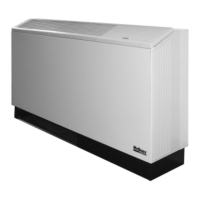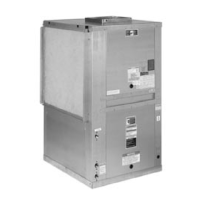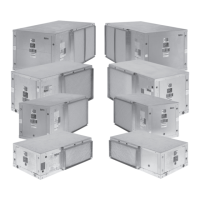IM-447 / Page 19
Maintenance
Compressor attempts to start but doesn’t:
1. Check capacitor.
2. Check for defective compressor by making resistance
check on winding.
3. Check run capacitor.
Compressor runs in short cycle:
1. Check thermostat mounting and location.
2. Check all relays, relaying and contacts.
3. Check run capacitor.
4. Check high pressure switch.
5. Check low temperature switch.
6. See if reversing valve has not fully shifted to either side.
Insufficient cooling or heating:
1. Check thermostat for improper location.
2. Airflow may be insufficient. Check and clean the filter.
3. The reversing valve may be defective, creating a
bypass of refrigerant. If the unit will not heat, check
the reversing valve coil.
4. Check capillary tubes for possible restriction of
refrigerant flow.
5. Check for restriction in water flow.
Insufficient water flow through condenser:
1. Check to see that valves are open all the way.
2. Check for air in lines.
3. Check circulating pump.
Water drips from conditioner:
1. Check for plugged condensate drain.
2. Check for dirty filter.
3. Check to see if condensate drain runs uphill.
4. See if blower motor is up to speed.
5. Check for loose or mispositioned blower.
6. Are drains properly trapped?
Noisy unit operation:
1. Check for fan wheel hitting the housing. Adjust for
clearance.
2. Check for bent fan wheel. Replace if damaged.
3. Check for loose fan wheel on shaft. Tighten.
4. Make sure compressor is floating free on its isolator mounts.
5. Check for tubing touching compressor or other sur-
face. Readjust tubing by bending slightly.
6. Check screws on all panels. Tighten.
7. Check for chattering or humming in the contactor
relays due to low voltage or a defective holding coil.
Replace component.
8. Check water balance to unit for proper water flow rate.
1. Filter changes are required at the regular intervals.
The time period between changes will depend upon
the project requirements. Some applications such as
motels, produce a lot of lint from carpeting and linen
changes, and will require more frequent filter
changes. It is suggested that the filter be checked at
60 day intervals for the first year until experience is
acquired. If light cannot be seen through the filter
when held up to sunlight or a bright light, it should be
changed. A more critical standard may be desirable.
2. The condensate drain pan should be checked annually
and cleaned and flushed as required. Note: Mark IV/
AC equipment has a condensate overflow control device.
In cooling, if compressor will not operate, it may be
due to unit compressor lockout on condensate overflow.
3. Recording of performance measurement of volt amps
and water temperature differences (both heating and
cooling) is recommended. A comparison of logged
data with start-up and other annual data is useful as
an indicator of general equipment condition.
4. Periodic lockouts almost always are caused by air or
water problems. The lockout (shutdown) of the condi-
tioner is a normal protective result. Check for dirt in
the water system, water flow rates, water temperature,
airflow rates (may be dirty filter), and air temperatures.
If the lockout occurs in the morning following a return
from night setback, entering air below machine limits
may be the cause.
5. When checking unit operation, it is important to
gather the correct information.
a. Take voltage reading.
b. Amp reading in both cooling and heating mode
operation.
c. Water temperature difference in both cooling and
heating mode.
d. Air temperature difference in both cooling and
heating mode. Air termperature difference in
cooling mode should include both wet and dry
bulb temperatures.
6. Also record model, catalog, and serial numbers.

